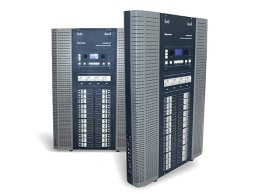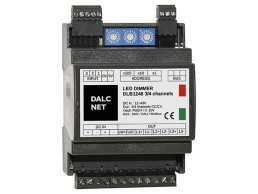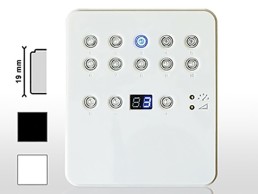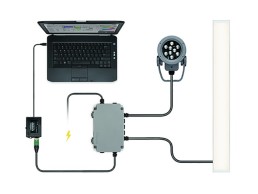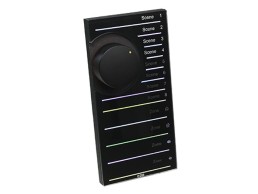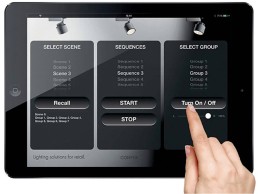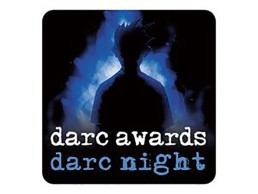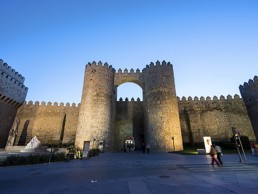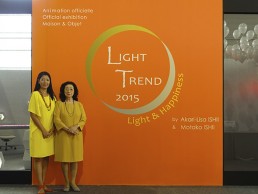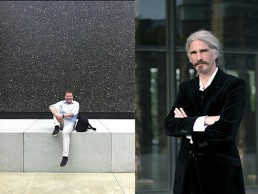Electron Premium Series
Premium Series of multi functional custom made power controllers is now available with new power units with Trailing Edge dimmers for LED lamps, CFLs and electronic transformers for Trailing Edge dimming.
Premium Series is available from six channels up to 48 channels. There is a possibility to have different power units that control different types of loads in the same Premium. Thus, one Premium can have Trailing edge dimmers, Leading edge dimmers, HF fluorescent controllers (1/10V) and relay switches, in the same enclosure.
Dalcnet LED Dimmer PRO Series
The LED Dimmer PRO can have four independent channels or RGB+W. It has been studied for professional applications and is available with different commands: DMX/RDM, DALI, MODBUS protocols.
All versions have analogic command such as a push-button, 0-10V, and potentiometre. Its supply voltage is from 12 to 48V DC, with an output current of up to 20A. With its extended range of working temperature (-40°C +60°C), it is perfect for harsh environment applications. The dimmer is also available in constant voltage or inconstant current.
Chromateq LED Player V.1.5.1
The new release for Windows and Mac OS offers additional features, including a new firmware for LPSA-SLIM, as pictured, that can automatically repeat a scenario every week, month and year.
Scenes can stop automatically at a specific time and date; memory content can be read and loaded in the software. It also has four additional master/slave modes and merges DMX signal. LED Player includes many new powerful options like Studio DMX to quickly create and simulate complete outdoor and indoor 3D environments in real time.
Lumenpulse Remote Device Management
Remote Device Management (DMX/RDM) is an enhancement of DMX, allowing full bi-directional control and communication for simple, convenient commissioning.
With DMX/RDM, luminaires can communicate important information, such as their address, status, temperature and predicted lifetime expectancy. They can also be discovered, updated or re-commissioned at any time. By giving luminaires a voice, RDM simplifies the maintenance of your lighting system, isolating and identifying potential issues and problem devices.
Tridonic connecDIM
connecDIM is Tridonic’s new platform for intelligent lighting control. The connecDIM Gateway is the heart of the system; this hardware offers data acquisition and the conversion of control commands from TCP/IP to DALI. This means that wireless lighting management will be possible from any iOS or Android smart device. The gateway operates both with the tried and tested DALI standards and with IT technologies. Existing and newly installed DALI systems can be easily connected with the connecDIM cloud.
Traxon & e:cue LIGHTDRIVE Aura
The e:cue LIGHTDRIVE Aura is an easy to use wall-mounted standalone controller for DMX512 controlled monochrome, dynamic white, RGB and RGB-W fixtures. It features keys and a jog wheel with colour LEDs for intuitive selection of colours and adjustment of intensity and speed which makes it an accessible user terminal for small to mid-sized projects in a variety of retail and hospitality applications. For this purpose, LIGHTDRIVE Aura is designed with a glass front and features dry contact inputs and outputs as well as an Ethernet port.
Ansorg Easy
Easy lighting control system permits easy and wireless lighting control for salesrooms. By means of Bluetooth technology, LED luminaires from Ansorg can be easily controlled and individually regulated via a tablet. Easy provides the retailer with the opportunity to adapt lighting directly and creatively to changed merchandising and by means of lighting scenes to create attractive experience values. With an additional calendar function, lighting design can be scheduled according to date and time, and can be shared between other tablets.
darc awards winners announced
(UK) - darc night a celebration of the best in architectural and decorative lighting design with a spectacular display of lighting installations.
The winners of the darc awards were announced at darc night, the awards ceremony, that took place at Testbed1 / Doodlebar in London on September 24th.
They were:
Best Interior Scheme - High Budget and darc award (project with the most votes): Fulton Center, New York, USA by Arup, USA
Best Interior Scheme - Low Budget: Sorae Sushi Sake Lounge, Ho Chi Minh City, Vietnam by ASA Studio, Vietnam
Best Exterior Scheme - High Budget: Sczcecin Philharmonic, Sczcecin, Poland by Anoche, Spain
Best Exterior Scheme - Low Budget: Shadow Play, Hämeenlinna, Finland by WhiteNight Lighting, Finland
Best Landscape Scheme - High Budget: UK Pavilion, Milan Expo 2015 by BDP, UK
Best Landscape Project - Low Project: Memories of the Mirror, Barceolona, Spain by Lupercales, Spain
Best Light Art Installation: Light Bariier by Kimchi and Chips, Korea and UK
Best Decorative Lighting Installation: Emergence, Heathrow T2, UK by Cinimod, UK
Best Unrealised Lighting Concept: Maritime Museum of Denmark by Lucia Moreno Abenojar – Lumabe, Spain
Best Interior Architectural Lighting Product: Laser Blade by iGuzzini
Best Exterior Architectural Lighting Product: VarioLED Flex Venus by LED Linear
Best Decorative Lighting Product: Dimple by ByBeau
Free admission to darc night was available to independent lighting designers that voted as well as to interior designers and architects (lighting suppliers will be subject to a charge) turning the traditional awards ceremony protocol on its head. The awards evening was a complete change to the norm with free street food and drinks all night, lighting installations by lighting designers who have teamed up with the sponsoring manufacturer partners, and a completely different format for presenting the evening.
There were over 400 entries for the darc awards, an amazing response to an inaugural competition and proof that designers are looking for something new and refreshing. Decorative lighting categories consist of Best Decorative Lighting Installation, Best Light Art Installation and Best Decorative Lighting Product.
Projects were shortlisted by an international panel of professional architectural lighting designers and light artists before being voted on by the lighting design profession in the first ever peer-to-peer lighting design awards.
Product categories (both decorative and architectural) went straight to the public vote so that lighting designers could genuinely vote for their favourite products from the last three years.
Manufacturer partners are Concord (who are teaming up with Speirs + Major); Cooledge (Light Bureau); Griven (Paul Nulty Lighting Design); Innermost (Elektra); KKDC (dpa); L&L Luce&Light (LDI); LSE Lighting (Troup Bywaters + Anders); Lucent (Michael Grubb Studio); Lumino (Electrolight); Megaman (Design In progress); Reggiani (BDP); and Zumtobel (Arup).
Each manufacturer / designer team was responsible for creating a lighting installation that was on display during darc night.
The technical partner at darc night was XL Video and the awards were manufactured by Applelec from a unique design by Kerem Asfuroglu of Dark Source who's dark graphic novels were the inspiration for the branding of darc night. The event was curated by Light Collective and is part of the International Year of Light 2015 programme. The darc awards is supported by both the International Association of Lighting Designers (IALD) and the Society of Light + Lighting (SLL).
City.People.Light awards winners announced
(Finland) - City of Avila wins first prize for city centre lighting masterplan New Nightscape in 13th annual City.People.Light awards.
The city of Avila in Spain has been awarded the first prize for its city centre lighting masterplan New Nightscape in the 13th annual City.People.Light awards ceremony on 25 September 2015 in Helsinki, Finland.
Valenciennes (France) and Baia Mare (Romania) have won the second and third prize respectively. The cities of Amsterdam (Netherlands) and Taipei (Taiwan) both received special mentions, and Melilla (Spain) won the People Choice award with the most votes.
The international City.People.Light award, created in 2003 by LUCI and Philips, recognises urban lighting projects that attempt to rehumanise the urban environment through the medium of light.
First prize: New nightscape lighting masterplan, Avila (Spain)
The lighting designer of the winning project in Avila, Rafael Gallego from Aureolighting, commented: “Ávila's new nightscape is a project to upgrade all the existing street lighting in the urban area to have both a functional and ornamental purpose. The new lighting plan reinforces the city's outstanding cultural values while being infused with the philosophy of conservation that has given the city such a proud heritage. The lighting masterplan for Avila is based in a new lighting philosophy that takes into consideration four areas: functional, architectural, commercial and festive lighting.’’
The jury commented: “The use of light is well thought through in the entire city, taking into account urban design principles such as sustainability and the architectural integration of the lighting systems.’’
Second prize - Artistic escapes at twilight, lighting masterplan, Valenciennes, France
This lighting masterplan covered the renovation of 41 existing architectural lighting systems and the creation of nine new architectural lighting projects. It includes the lighting of two of the principal nocturnal routes through the city, 1,100 metres and 700 metres long, that meet in the very centre of the town. The interactivity of city lights with inhabitants inspires people to walk in the city at night, to once again discover the magnificence of their architectural heritage. The lighting design was executed by French lighting studio CONCEPTO.
Third prize - Rehabilitation of Fortress Square, Baia Mare, Romania
The project is part of the urban masterplan that started in 2005 and is a cultural component of the entire Baia Mare city centre reconstruction in north-western Romania. The purpose of this project was to restore the memory of the most important city monument - St. Stephen's Church - related to the birth of the city. The lighting provides an ambient atmosphere that highlights buildings, trees, major city routes and emphasises the main landmarks of the city: St.Stephen's Tower, the ruins of St. Stephen's Church and of the two other churches that were discovered, the Church of Saint Catherine and the Saint Martin Church. The lighting design was created by Mitru Ildiko, chief architect for the project.
Special Mentions for projects from Amsterdam and Taipei
A dodgy passing under a railway bridge "Hang in there", Amsterdam, The Netherlands
The design is based on a composition of 36 beams of light positioned above the water upon an old railway bridge next to Amsterdam's central train station. The beams light up and fade away randomly and create a mesmerizing spectacle of light and reflection, making the underpass a more attractive place to pass through. The poorly lit underpass with the ground shaking noise of trains passing overhead has become an important route for buses, trams, bike riders, cars and pedestrians (both locals and tourists) due to its position connecting the old historic city on one side with the new urban developments on the harbor front on the other side. The lighting design was developed by Jasper Klinkhamer and Matthijs ten Berge.
Treasure Hill Village, Taipei, Taiwan
The Treasure Hill community is located in the Gonguan district of Taipei by the Xindian River, an important lifeline for the village. The community used to have extensive urban farms between the settlement and the river. The lighting concept emphasizes the former practice of urban farming in this area to redefine the borders between nature and urban life. The lighting design was developed by Ivan Juarez from x-studio.
People's Choice award 2015
Victoria Grande" Fortress, Melilla, Spain
This fortress was a military construction conceived as a defense bastion, which later became a prison, and finally a damaged ruin. Since its reconstruction, it is now a well visited complex open to the public. The lighting design enables interesting nocturnal displays at nights. The lighting design was done by Javier Górriz from DCI Design study and lighting consultancy.
New employees at Elation Europe
(Netherlands) - Elation Professional strengthens European team with Dennis Scipio, Nancy de Lang and Carola Ludermann.
As a result of Elation's continued growth in the European market, Elation Professional B.V. is pleased to announce three new hires at its European headquarter office in Kerkrade, The Netherlands.
Dennis Scipio joined Elation Europe on October 1st as a new Key Account Manager. Responsible for managing some of Elation's most strategically important customers while helping to grow the business, Scipio has a wealth of experience in business development and international sales. He comes to Elation from German lighting manufacturer SLV, where he was responsible for marketing and corporate communications. Prior to that, he worked in an international sales role for Dutch lighting company Highlite International B.V.
Also joining Elation on October 1st and working as the European office's new office assistant is Nancy de Lang. de Lang comes to Elation from The Netherlands-based industrial manufacturer Kobelco Welding of Europe B.V., where she worked as a Production Planner and Administrator. She will be handling a variety of administrative tasks in her new position as well as customer contact.
Joining Elation in August as an assistant in the company's marketing and graphics department is Carola Ludermann. Ludermann's responsibilities include general marketing duties such as catalog and ad creation, web page maintenance, product photography and social media.
Light Trend, France
Maison et Objet Paris 2015 saw Japanese lighting design team Akari-Lisa Ishii (daughter) and Motoko Ishii (mother) present the latest trends in lighting, after the success of their previous exhibition at the show over the past two years.With M&O’s redesign and new target marketing, the importance of lighting is prominent, notable in the wide coverage given to lighting designers in the thematic exhibition of their designs. The Japanese duo’s stand Light Trend was placed in the 'Projet' hall, along the red carpet linking the must-see stands throughout the fair.
With increasingly evolving technology, lighting plays an ever more important role in interior design; Light Trend aims to present the latest technologies in lighting while suggesting integration of light and fixtures in a space. The different spaces presented live exclusive lighting experiences comprised through a collaborative effort between lighting manufacturers and designers. Under the sub-theme of happiness, Light Trend strives to bring happiness to the heart, body and environment in honour of the UNESCO International Year of Light and M&O’s 20th anniversary, to be shared with leaders of light and guests within the field of lighting design from all over the world.
Light Trend consisted of seven rooms, presenting different approaches to the pursuit of happiness. Visitors walk through each one, experiencing diverse expressions of light throughout. The first room, titled <em>'Perception of Happiness' featured a video realised by I.C.O.N., Akari Lisa Ishii’s lighting design office, and Motoko Ishii Lighting Design, demonstrating the relation between facial expressions and light, using a Japanese mask of Noh as an example. In this space several lighting fixtures were presented to create a cheerful effect, with Artemide’s Cata and Picto lights behind the reception desk, and Artemide’s acoustic Egg Board to reassuringly stifle aggressive noise. The room also featured Artemide’s Spectral Light, a multi-coloured conceptual light object dedicated to well-being based on the concept of perceptible wave length of light.
The second room then focused on 'Happiness to the eyes'. Here, organic LED (OLED) presented a colourful light composition manufactured by Sumitomo Chemical, showing the word happiness, using exclusive technology to create dual-colour OLED panels. Moving through to the third room, 'Happy Time!', guests were greeted with a colourful lighting effect through ERCO's Cantax RGBW and balloons, while tasting sweets and sparkling drinks to activate the brain and complement the cheerful ambience.
In the fourth room, 'Do I look happy?', guests were given the opportunity to experiment with how the angle of light cast across a face can affect mood and attitude projection in diverse scenes in daily life, demonstrating how light influences the way we perceive and are perceived by others. Lumenpulse Alphaled Spot Apto shone down above the guest, standing in front of a mirror, watching the way the shadow changed.
'Mental Happiness', the fifth room, featured a meditating room that used KKDC lights of soothing colours and healing music within an aluminium structure developed by Technilum, filled with Shiseido perfume to enhance feelings of mental happiness and tranquility. The sixth room focused on the idea of SOHO (Small Office Home Office) systems, titled 'Environmental Happiness'. This room presented propositions of lighting products by Okamura and Stanley Electric launched at M&O that aim to balance the productivity of a working space while maintaining the comfort of a home.
The seventh room by the name of 'Technology and Happiness', used an interactive control system linked to a moving detector and an original chandelier, custom-made for M&O, demonstrating previously unseen lighting effects, all manufactured by Stanley Electric. This room also included educational demonstrations of tips on lights in interior design, such as colour temperature and colour rendering.
With all rooms designed by the mother and daughter duo, Light Trend presented a variety of applications in architectural lighting with a focus on its human importance in emotion and impact. The exhibition was a collaborative effort between leaders and trend setters in the field, and stood as a strong exhibition along the red carpet of Maison et Objet.
All pics courtesy of I.C.O.N. and Motoko Ishii Lighting Design
Rik Nys and Alexander Schwarz
David Chipperfield Architect’s portfolio of international work spans over 30 years with examples of their prestigious buildings found in diverse nations from Mexico to Sweden. With offices located in London, Berlin, Milan and Shanghai they are well placed to deliver their expertise globally.
The Berlin practice has recently been highly acclaimed for the renovation of the culturally significant Neues Museum in Berlin; an intricate and difficult project, which took over twelve years from start to completion. It boasts some of the most carefully considered and beautifully detailed design ever seen in a museum refurbishment project; all of which works to deliver impressive, flowing and tactile spaces glowing with natural light. It is this very specific approach to light as an intrinsic part of architecture that can be argued as breathing life into DCA’s designs.
The Berlin office is now working on another renovation project for Die Neue Nationalgalerie from Mies van der Rohe, also based in Berlin. This is one of Germany’s most important contemporary art galleries and a jewel of late modernist design in which the play of light, shadow, space and the structure of the building are as important as the exhibits. The practice admits to having a democratic and consensus approach to the design of their projects, which is promoted by David Chipperfield himself. This is facilitated through specific team structures that help to deliver clarity of communication. Each office around the world is staffed by architects and support staff but led via a team of directors who shadow and enable the project managers and architects in their work. Many of the directors have unusual and diverse backgrounds, which help the offices with the delivery of their specific approaches to design. I spoke to Design Directors Rik Nys, from DCA London and Alexander Schwarz from DCA Berlin to try and find out how they work with light as part of their architectural palette.
Schwarz originally trained as a violin maker, but despite being rewarded and happy in this profession, found it lonely and partly based in a bygone time and culture. He wanted to extend his expertise to deliver more holistic and universal designs, so decided to study architecture in Stuttgart at the ETH Zürich (Eidgenössische Technische Hochschule). It was in Stuttgart where Schwarz met Chipperfield who was working as a guest professor there and asked Schwarz if he would like to join his practice. In 1996 Schwarz went to work for DCA in London on the competition for the Berlin Neues Museum. After winning the competition he moved to Berlin in 1998 and became one of the founding members of the Berlin office. DCA was the first architectural practice that he had worked for and he found this experience, together with that of the design for the Neues Museum, as life changing. He describes the design process for the museum as being like a ‘second study’ for all the designers and the museum directors who worked on it, and seminal to the definition of the DCA office culture and attitudes.
When asked about the most interesting and influential projects for DCA in terms of lighting design Schwarz cited the Neues Museum, the James Simon Gallery and the Gallery building ‘Am Kupfergraben 10’ which are located near to the Neues Museum in Berlin; but also The Hepworth, Wakefield gallery in West Yorkshire, UK, the Museum Folkwang in Essen, and from a personal perspective the Museum of Modern Literature in Marbach am Neckar; which is located near to his home town, and is the birth place of Friedrich Schiller and houses many of Kafka’s original works, including ‘The Trial’.
Schwarz considers daylight to be the most important form of architectural lighting with it often acting as the richest material. He believes it to be at the core of architecture and the most interesting phenomenon with its ever-changing fluid nature lending the experiential qualities to space and the perception of the architecture. In the context of the Neues Museum, it is used with subtlety to help guide visitors through the exhibition spaces enabling them to democratically choose how to view the exhibits without being specifically directed. He sees this approach as particularly successful in the Egyptian courtyard where the valuable Armana collection is displayed.
Schwarz considers that careful modulation of both natural and artificial light are important when defining and controlling space, right through from the skin of the building to its interior. He describes the recycled glass cladding of the Folkwang museum as having a special quality somewhere between that of glass and stone as it “kind of eats up the light and then radiates it back”. In the Museum of Modern Literature, lighting is used sparingly to protect the valuable manuscripts but also to create the appropriate contemplative atmosphere. He believes that lighting defines the mood of a space and that “if you light a room well, a person and the art can be seen in the same light”.
Achieving the specific lighting in a building requires attention to its material qualities and working with those who understand them. DCA have often worked with engineers Arup in the UK and Germany to achieve this, and with key designers such as Andy Sedgwick, who Schwarz describes as “being a pleasure to work with”.
Schwarz’s experience as a violin maker taught him the process of making, and gave him an understanding that architecture is also about making things albeit doing so in a dirty and heavy environment with a specific palette of materials including light. He believes that in this environment you must discover where the boundaries lie; learning to work with and love these boundaries thus defining the limitations of architectural possibility and the starting points for creation; bearing in mind that these boundaries are culturally specific and need to be respected. Any battles waged to be carefully chosen.
DCA’s approach to lighting design varies according to projects and within the different offices and as relevant to the design brief. The London office is now working on retail projects including the refurbishment of and design of new space for the Selfridges department store on Oxford Street, London. According to Rik Nys, Design Director in London, this project requires a number of different design solutions including those for shop windows, which interface with the street and connect the merchandise environment with customers and the products available inside. Within the retail space, market streets are created to connect specific brands and sales messages using material and light to sign routes and directions through the store. The aim of this is to create holistic identity but not to override individual brand identities. Here design is often used to focus attention and provide orientation.
The contrast of light and dark, umbra and penumbra are allowed to define space using a variety of different lighting fixtures and luminaires but also importantly natural light. Nys who said: “and when I say light, I almost always mean natural light,” is adamant about the importance of daylight as part of architectural design.</p> <p class="p1">Similar to Schwarz, Nys has an unusual and varied background; as a Belgian he studied architecture in Ghent, Louvain and at the Architectural Association in London. He also studied history and philosophy and has taught extensively in schools of architecture. Again like Schwarz and the DCA approach, he champions an understanding of the processes involved in actually making things as integral to the production of good design. This vitally includes for the building of scale models of buildings and building components which can be used to tangibly understand space and model light together with other aspects of a building’s design such as façades and shading etc. Such models are also important to communicate designs and design intentions to clients and are often much more useful than digital models in achieving this.
Nys admits that creating the desired lit environment for a space also often requires the production of special luminaires and to do this DCA have built up relationships with a number of manufacturing and design partners including Artemide, Viabizzuno and Zumtobel. The production of such individual design items means that the identity of the architecture can be reinforced and supported, but also creates design items that can be used as part of other projects and potentially by other architects and designers.
Schwarz and Nys have different but similar ideas about the use of light in architecture, but their combined approaches start to describe an overall DCA philosophy. A central theme of this is the use of natural light as a key design material but also the use of intricate and careful details and a respect for cultural significance and meaning. Light is used to build architecture and experience, and to focus, guide and reflect attention within physical, emotional and intellectual space, allowing for relevant boundaries to be observed.


